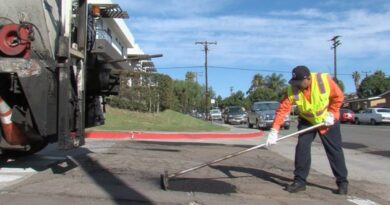Magic Johnson sees smart tech as way to close societal gap – The San Diego Union-Tribune
Can streetlights help end the digital divide in cities?
Maybe they can if they’re smart. Qualcomm showed off streetlights at its San Diego campus on Monday that not only dim, brighten and flash red as pedestrians approach crosswalks but also serve as Wi-Fi hotspots.
This week, the wireless technology company hosts its third Smart Cities Accelerate event, which was expected to draw more than 300 city officials and technology providers in person and close to 700 virtually. It’s part of Qualcomm’s effort to pave the way for a fragmented group of Internet of Things technologies to digitally transform urban centers.
NBA Hall of Famer Earvin Magic Johnson, co-founder of JLC Infrastructure, helped kick off the conference, along with fellow JLC co-founder Jim Reynolds and Qualcomm Chief Executive Cristiano Amon. Last year, JLC announced that it would allocate an initial $75 million in capital for investment in urban projects developed in collaboration with Qualcomm and others.
“This is the biggest thing to date that we need,” said Johnson. “When you think about smart cities and think about technology, you think about connecting everybody, not just the rich, not just the middle class. I’m talking about the poor now. Minority students suffered during a pandemic because of virtual learning and no access to the Internet.”
Connectivity also is vital for virtual health care, said Johnson. During the pandemic, his father was having pain in his leg. He was able to get virtual appointment, and his physician strongly recommended that he get to the hospital right away or risk amputation, said Johnson.
“Because they jumped on it, and they were able to give him medicine at the hospital, it saved his life and saved his leg,” he said. “We have so many people who are not connected.”
The conference, which continues through Wednesday, will center on several emerging technologies trends in smart cities,
Here’s a look at four ways smart cities are shaping up with Qualcomm’s help.
The ecosystem
Three years ago, Qualcomm launched its Smart Cities Accelerator to connect municipalities with companies working on hardware and software to digitally transform transportation, venues, corporate campuses, warehouses, health care facilities, schools and so on.
Today, more than 400 entities are members of the Smart Cities Accelerator program.
“Everybody talks about the Internet of Things, but it was so fragmented,” said Sanjeet Pandit, global head of smart cities for Qualcomm. “We really needed a depository of where all of the industry is. So, we created the Smart Cities Accelerator Program. For lack of a better term, it is the Match.com of smart cities.”
It’s still early days. While there’s interest, smart cities technologies aren’t widely deployed yet.
But interest is growing, particularly following COVID-19 shutdowns, said Pandit. Qualcomm has pitched the city of El Cajon, for example, to become the region’s first 5G-enabled smart city. Talks are ongoing.
“There has always been pessimism on smart city rollouts, but this pandemic acted as a catalyst to adoption of technology by cities,” he said. “They realized maybe they procrastinated a little too much in investing in these areas.”
Smart campus
Qualcomm’s 40-building campus in Sorrento Mesa has been set up as a demonstration smart city — complete with digital command center.
Through an app, employees can see available parking spots. If they forgot where they parked, they can ask a kiosk to search by partial license plate, car color or make and model of their vehicle.
Smart trash cans include solar-powered compactors. They notify maintenance staff when they’re full, eliminating unnecessary trips. And the trash cans are also Wi-Fi hotspots — complementing the streetlight hotspots.
Digital whiteboards facilitate in-person and virtual collaboration. There’s also full building energy management, camera and LIDAR security, fleet management, asset tracking and logistics management.
Business models
Municipalities and venue operators control valuable urban real estate — whether that’s roads, streetlight poles, sidewalks, parking garages, convention centers, stadiums, airports .
Each provides an opportunity to monetize smart cities technologies, said Pandit. For example, free public Wi-Fi kiosks in New York City rely on advertising to generate revenue.
Sending a crew to empty trash cans only when they’re full reduces scheduled maintenance costs. Knowing which parking spots are most popular can be used to optimize pricing.
“We are using the technology to solve a problem and that can be monetized by the city so it can be sustained over a period of time,” said Pandit.
IoT-as-a-service
One way to keep costs down is to offer smart cities technologies as a subscription service or a revenue-sharing opportunity. Qualcomm and its partners have targeted 30 industries for this type of program.
They include traffic management with No Traffic, a firm that has developed technologies aimed at reducing traffic congestion and CO2 emissions.
With smart venues, Qualcomm and TheIndoorLabs have teamed up to enable a Lidar-based security system that alleviates privacy concerns while enabling crowd and space management. Lidar displays images akin to a heat signature without fine details such as facial features.



